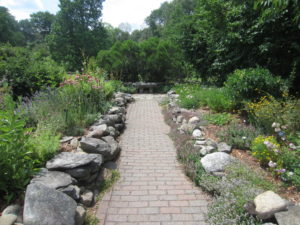Acton Arboretum Herb Garden
In 1976-77 the Town of Acton purchased 53 acres of conservation land representing a varietyof natural habitats including deep woods, meadows, swampland, a pond, an old apple orchardand a glacial esker. In 1986 an amended town article specified that the land be used for TheActon Arboretum. In 1989 and invitation was extended to the Acton Garden Club toresearch and develop a period herb garden in a historical foundation on the site.
The land where the foundation in located was owned by the Reed Family prior to the Revolutionary War. The Tuttles later put in an orchard and John Craigin eventually built a house, assumed to have been located on the foundation visible from Taylor Road. After the house was moved, a shed was built to store the orchard and farming equipment. The shed burned down in the 1960’s.
Once the decision was made to establish the herb garden, in the initial clearing out of the foundation, restoration of the stone walls, and filling in the raised beds was done by the conservation administrator, Tom Tidman, and other town staff with recommendations from the Acton Arboretum Committee.
The objective of the project was to provide an historical and educational exhibit of herbs at the arboretum appropriate to the mid 19th century to be enjoyed by residents and visitors of Acton. Acton Garden Club member, Sue Whitcomb prepared a design plan. Herbs selected were representative of the period, however some new cultivars were substituted for old cultivars that were not winter hardy or would have originally been located in and around the kitchen door yard area.
The Acton Arboretum is located at the intersection of Main Street and Taylor Road.
The Herb Garden is one of the many attractions of the Acton Arboretum. This garden was developed by the Acton Garden Club in 1989 and has been maintained by them since then. It can be reached by following the paved path to the left of the entrance from the parking lot. If one is curious how a typical kitchen garden of the 1800s might look, just take a walk there. Kitchen gardens of that day not only contained herbs for cooking, but also herbs for brewing tea, herbs for soothing minor ailments, and herbs just to delight the senses. The garden is enclosed in an old stonewall and is surrounded by lilacs and flowering trees. It is divided into beds and contains a combination of perennial and annual herbs. A profusion of colorful flowers, leaf textures, and fragrances are produced throughout the spring, summer and fall. In winter the structure of the garden stands out against a background of fallen snow and interesting seed pods may peep above the snow.

